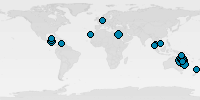
Shark Cave is a wicked cave with chambers, caverns and even a tunnel that exits the island.
| Name Dive Site: | Shark Cave |
| Depth: | 5-25m (16-82ft) |
| Inserted/Added by: | burma_liveaboards |
| Rated: | Rated 5.0, 1 votes |
| Specifications: |    |
Send us your images for this dive site[Add Image][Add Movie]
The larger and middle of the three islands is the one with the cave that has made the dive site famous. The cave starts as a large cavern entrance on the northwest corner of the island at 5m below the surface and drops down to 16m deep. The cavern gradually narrows inside until forming a tunnel about 20m long through to the east side of the island. There is a smaller tunnel chamber accessed by a meter wide hole. Large tawny nurse sharks are the most common sharks seen in the tunnel. Grey reef sharks are also seen on the outside of the tunnel and some divers encounter them as they swim through the tunnel which can get the heart pounding a little faster. Although grey reef sharks have been known to show aggression to divers, as long as you stay low and to one side of the tunnel and allow the sharks' free passage, there should be no problems. Surge can make current difficult to navigate at times.
The cavern entrance is full of fish including longfin trevally, yellow tail barracuda, cave sweepers and glassfish. Lionfish and bearded scorpionfish also frequent the cave. Shrimps and nudibranchs are also numerous and a good dive light will help to illuminate the darker crevices. Also look out for moray eels in the cracks between sponge encrusted rock and zigzag clams.
Most divers exit the tunnel on the east side and turn left to the north where a sloping reef down to 25m is covered with hard and soft corals, sea fans and feather stars. Magnificent anemones are home to the western clownfish and carpet anemones to Clark's anemonefish. Pink anemone fish and tomato anemone fish are also present. On the edge of the reef in the sand it is common to see double ended pipefish. In the sea fans, ornate ghost pipefish and seahorses can be found. Common and twin spot lionfish are numerous. Banded sea snakes are often seen hunting over the reef. All the usual reef fish including schools of snapper and fusiliers plus sweetlips and wrasse are abundant.
Visit our partners! Or become one.
Liveaboard, Charter
- Mergui Travel, 165, 35th st., YangonMergui Travel
| Travel to Mergui Archipelago www.merguitravel.com +95 9 5150660 + 95 1 245230 | 165, 35th st. 11181 Yangon |
Mergui Archipelago, located in southernmost part of Myanmar (Burma), comprises over 800 beautiful islands. Due to its virtual isolation, the islands and surrounding seas are alive with an amazing diversity of flora & fauna and very beautiful underwater scenes and marine life. The only human inhabitants in the area are sea gypsies, namely Salon in Myanmar. They live on boats during dry season and remain on land during rainy season. They still practice the same fishing and boat building techniques used for generation.
Mergui Archipelago, located in southern most part of Myanmar (Burma), comprises over 800 beautiful islands. Due to its virtual isolation, the islands and surrounding seas are alive with an amazing diversity of flora & fauna and very beautiful underwater scenes and marine life. Mergui Photo The only human inhabitants in the area are sea gypsies, namely Salon in Myanmar. They live on boats during dry season and remain on land during rainy season. They still practice the same fishing and boat building techniques used for generation. Being affectionate to sea, much skilful in swimming and diving, their ways of life and customs are so characteristic that traditional festival will be launched intending to attract international tourists as well as to operate marine eco-tourism around the islands in Archipelago. Just north of the Surin Islands, an imaginary line divides Thai waters from Myanmar's Mergui Archipelago. Also known as the Archipelago, this immense area covers approximately 36,000 sp km (14,000 sq miles) and included roughly 800 islands. Diving here is still in its infancy, as the entire region has been off-limits to outsiders since the late 1940s. After several years of negotiation by Phuket dive operators, the archipelago was opened for tourism in 1997, yet much of the area remains unexplored. The islands are similar to their Thai counterparts, with rugged, high-profile limestone and granite topography. One obvious difference, aside from the sheer number of Myanmar islands, is their unspoiled terrestrial scenery. Dense brush and rainforest cover most areas above the high-tide line, while vast stretches of mangroves and magnificent white-sand beaches are interspersed with rocky headlands, tidal creeks and a few freshwater rivers. Though several of the larger islands are home to small communities of Moken 'sea gypsies,' the vast majority are uninhabited and largely untouched by humans. Underwater, this region offers scenic reefs, fascinating topography and prolific fish and invertebrate life. One of the main attractions for divers is the strong possibility of seeing big animals, especially sharks and rays. More dependable, however, is the tremendous variety of smaller fish and reef creatures, including many unusual species, some of which are rarely encountered in Thai waters. Add to this the allure of diving where few people have before and you've got all the ingredients for a top-notch dive destination. Considering the vast number of islands and reefs, many more dive sites are undoubtedly waiting to be discovered.
[Add Message]Messages from readers:
[Add Divelog]Divelogs from members:
